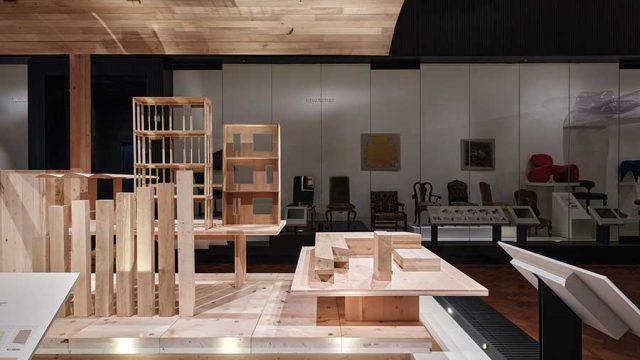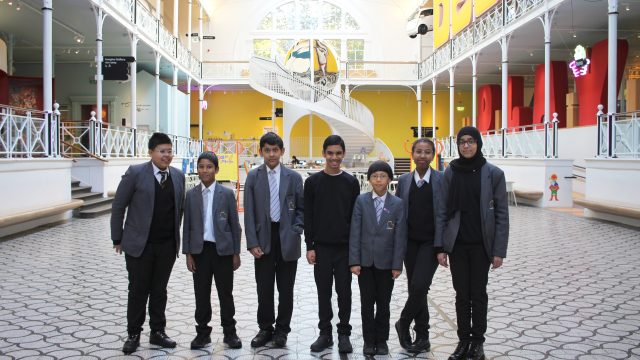Gitta Gschwendtner’s Bodge Bench is one of the first acquisitions made through the V&A’s Make Good: Rethinking Material Futures programme , a ten-year research initiative that explores the use of natural, renewable materials and the future of sustainable forestry in design and architecture. Handcrafted in an English woodland, the bench is one of many compelling projects featured in the inaugural Make Good display From the Forest, on show until the end of October 2022 in The Dr Susan Weber Gallery of Furniture at V&A South Kensington. The piece is also destined for future display in the V&A East Museum Why We Make Collection Galleries, opening in 2025 in Queen Elizabeth Olympic Park. Across these displays, we investigate the power of the forest as a site of sustainable making. From models of stewardship drawn from the history of forestry to the inspiration offered by vernacular making traditions, we explore how design projects with wood can inform ecological thinking for the future.
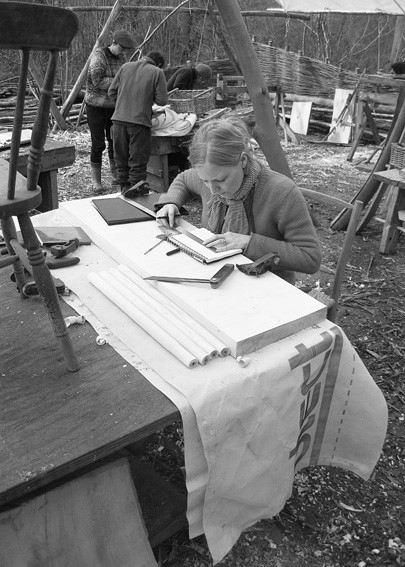
For east London-based designer Gitta Gschwendtner, the Bodge Bench was her first foray into the practice of ‘bodging’, a traditional form of furniture craft that relies on handmaking and freshly-cut ‘green’ wood. It is a technique best known for producing Windsor Chairs, which are characterised by their solid wood seats with legs and arm-supports dowelled into them. Examples of this type of chair date back to the early eighteenth-century.

We are thrilled to acquire Gschwendtner’s original Bodge Bench and explore its story.
The bench was made as part of the first-ever ‘Bodging Milano’ project in 2010, an initiative spearheaded by artist and designer Chris Eckersley that aims to inspire contemporary experimentation with greenwood furniture making and showcase it in the context of major furniture and design fairs, such as the annual Milan ‘Salone del Mobile’, among others. Bodging Milano 2010 brought together a group of nine furniture designers, including Amos Marchant, Carl Clerkin, Chris Eckersley, Dave Green, Gareth Neal, Gitta Gschwendtner, Rory Dodd, Suzanne Barnes, and William Warren. Each was given the same brief: to create a bodged chair.
“I always think these kinds of projects where you get nine different minds to work on the same brief is always really interesting, because you get such a such a diverse outcome. And I also quite liked this idea of thinking on the spot.”
Gitta Gschwendtner
The group spent five days in Clissett Wood, Herefordshire in the outdoor workshops run by locally-based furniture maker Gudrun Leitz. With no power tools, computers or drawing boards, Gschwendtner and the other designers worked quickly to learn the techniques of bodging craft while creating their designs. The challenge was time-bound, with all pieces needing to be finished by day 5, and the group worked tirelessly, despite the cold and rainy weather of March.
“We learned techniques as we went along (…) as a sort of five day exercise, it’s really enjoyable, because it becomes a sort of experiment, but also something quite meditative about making, and exploring making technique.”
Gitta Gschwendtner
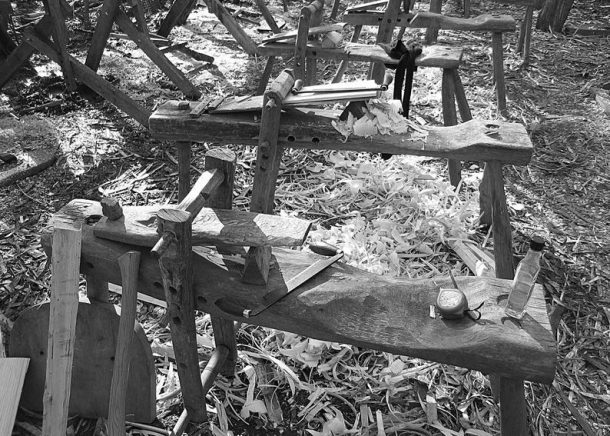
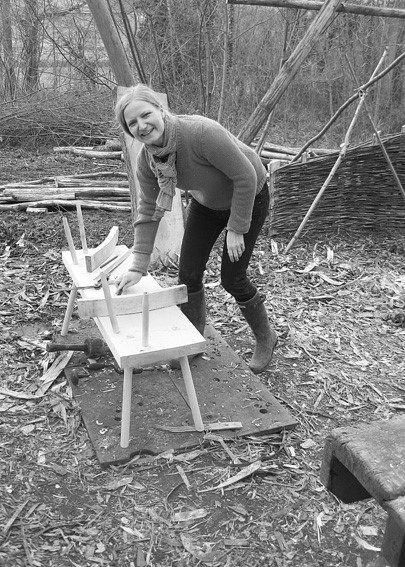
The designs produced as part of the Bodging Milano project are contemporary reinventions of Windsor Chairs. Gschwendtner’s Bodge Bench is a standout example from the series, playfully reinventing the traditional chair form as a two-seater bench with a bold geometric shape. Its long plank seat was inspired by the forms of the traditional ‘shaving horse’ workbenches found in the woodland workshop. While the inward-facing, angled backrests are to inspire a conversation between two sitters. The Bodge Bench is made from locally-sourced English woods, ash and sycamore. In keeping with the bodging tradition, the different woods are used strategically for their suitability for different parts of the chair’s design – ash for the legs, spindles and top rail, and sycamore plank for the seat. A glance on the underside reveals interesting traces of the original workshop making process, including Gschwendtner’s pencil markings for the design of the seat. The subtle undulating lines of the bench’s surfaces are a testament to its handmade process.
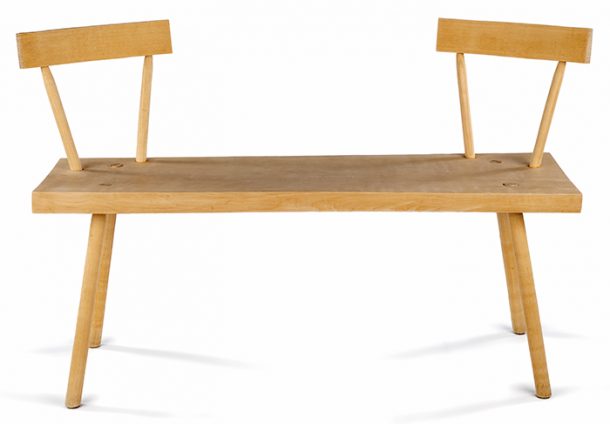
The Bodge Bench was a pivotal project for Gschwendtner, who has since gone on to further experiment with the Windsor Chair form, reinventing the original Bodge Bench in different sizes and in factory-made versions that use various English woods. These further iterations of the ‘Bodge Series’ were initially created as part of the Cov Bodge Project in the furniture factory of Dave Green in 2010. Subsequent pieces have been made as bespoke commissions for Stepney Green Design Week in 2012 and Guy’s Cancer Centre in 2016, for which Gschwendtner created a suite of furniture. From the forest to the factory, the ‘Bodge Series’ furniture reinvigorates a vernacular tradition.
For Gschwendtner, this traditional way of making encapsulates important values for sustainable furniture production. From an appreciation of forest ecology and the value of having a connection to where your tree material comes from, to the fundamental understanding of the time and labour it takes to make an entire piece of furniture by hand, from start to finish – bodging can inspire us to think. To Gschwendtner, this valuing of natural materials, time and labour has immense power to inspire care and longevity for the objects with which we surround ourselves in our daily lives.
“I think in some ways something like the Bodge Bench, or the bodging process is sort of what we all should be doing, but obviously we’re not. Because there is beauty and value that goes into making a piece of furniture that makes you kind of understand that you should be keeping this forever, because it’s taken a lot of time. It’s a bit like the idea of slow food, isn’t it? We should be eating local and seasonal. Why should we not be also making furniture locally and seasonally?”
Gitta Gschwendtner
And while mindful that such goals are often challenged in the context of growth-oriented economy, modern industrial production and economies of scale, Gschwendtner believes it remains important to hold on to such values and be open to dialogues with tradition.
The Bodge Bench now takes an important place in the V&A’s wider collection of Windsor Chairs, the earliest example dating from around 1720 to 20th-century experiments made in the 1950s by the Japanese-American designer George Nakashima.
In our future display at V&A East Museum, we look forward to exploring the Bodge Bench story further in our Collection Galleries. Here we will consider how global vernacular making practices and traditional ecological knowledge from across centuries can help inspire a more sustainable future.



